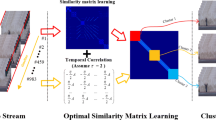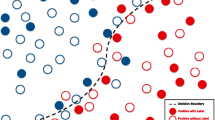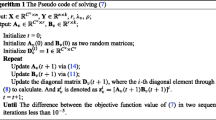Abstract
With the development of information technology and multimedia technology, a short video to become a user preferences, due to the long short and large amount of information become the user to be bestowed favor on newly, in order to find out from thousands of video two similar video, traditional approach is to extract the corresponding characteristic in the video, such as color, texture, gray level and other characteristics, and create the corresponding data index, Then put to query to extract the corresponding 3 d video features and compare the features in the database, so as to find the most similar 3 d video, the traditional way of data information is two-dimensional video is used, but in the data information of very large 3 d video efficiency and the effect is greatly reduced, and the results will greatly reduce the efficiency of the traditional data retrieval, Here, the method of principal component analysis without supervision problem is used to reduce the dimension of 3d video information, which can reduce the dimension from 128 to 64, thus greatly improving the efficiency of 3D video retrieval. Experimental results show that the method of principal component analysis for 3d data dimensionality reduction can greatly improve the efficiency of video retrieval.
Access this chapter
Tax calculation will be finalised at checkout
Purchases are for personal use only
Similar content being viewed by others
References
http://www.360doc.com/content/15/0331/07/20625683_459457113.shtml (2015)
Simonyan, K., Zisserman, A.: Very deep convolutional networks for large-scale image recognition. In: Proceedings of ICLR 2015 (2015)
Mensink, T., Verbeek, J., Perronnin, F., Csurka, G.: Metric learning for large scale image classification: generalizing to new classes at near-zero cost. In: Fitzgibbon, A., Lazebnik, S., Perona, P., Sato, Y., Schmid, C. (eds.) ECCV 2012. LNCS, pp. 488–501. Springer, Heidelberg (2012). https://doi.org/10.1007/978-3-642-33709-3_35
Russell, B.C., Torralba, A., Murphy, K.P., Freeman, W.T.: Labelme: a database and web- based tool for image annotation. Int. J. Comput. Vis. 77(1), 157–173 (2008)
Nair, V., Hinton, G.E.: Rectified linear units improve restricted Boltzmann machines. In: Proceedings of the 27th International Conference on Machine Learning (2010)
Lecun, Y., Huang, F.J., Bottou, L.: Learning methods for generic object recognition with invariance to pose and lighting. In: Computer Vision and Pattern Recognition (2004)
Shankar, K., Venkatraman, S.: A secure encrypted classified electronic healthcare data for public cloud environment. Intell. Autom. Soft Comput. 32(2), 765–779 (2022)
Endres, I., Hoiem, D.: Category independent object proposals. In: Daniilidis, K., Maragos, P., Paragios, N. (eds.) ECCV 2010. LNCS, vol. 6315, pp. 575–588. Springer, Heidelberg (2010). https://doi.org/10.1007/978-3-642-15555-0_42
Wang, X., Yang, M., Zhu, S., Lin, Y.: Regionlets for generic object detection. IEEE Trans. Pattern Anal. Mach. Intell. 37(10), 2071–2084 (2015)
Zeiler, M., Taylor, G., Fergus, R.: Adaptive deconvolutional networks for mid and high level feature learning. In: Computer Vision and Pattern Recognition (CVPR 2011) (2011)
Howard, A.G.: Some improvements on deep convolutional neural network based image classification. In: Proceedings of the ICLR 2014 (2014)
Perronnin, F., Sánchez, J., Mensink, T.: Improving the Fisher Kernel for large-scale image classification. In: Daniilidis, K., Maragos, P., Paragios, N. (eds.) ECCV 2010. LNCS, vol. 6314, pp. 143–156. Springer, Heidelberg (2010). https://doi.org/10.1007/978-3-642-15561-1_11
Li, F.F., Fergus, R., Perona, P.: Learning generative visual models from few training examples: an incremental Bayesian approach tested on 101 object categories. Comput. Vis. Image Underst. 106(1), 178–187 (2007)
Simonyan, K., Zisserman, A.: Very deep convolutional networks for large-scale image recognition. In: ICLR 2015 (2015)
Anil, K.J., Robert, P.W.D., Mao, J.: Statistical pattern recognition: a review. IEEE Trans. Pattern Anal. Mach. Intell. 21(1), 4–37 (2000)
Onshaunjit, J., Srinonchat, J.: Algorithmic scheme for concurrent detection and classification of printed circuit board defects. Comput. Mater. Continua 71(1), 355–367 (2022)
Huber, P.J.: Projection pursuit. Ann. Stat. 13(2), 435–475 (1985)
Palpandi, S., Meeradevi, T.: Development of efficient classification systems for the diagnosis of melanoma. Comput. Syst. Sci. Eng. 42(1), 361–371 (2022)
Zhang, X., Sun, X., Sun, X., Wang, P.: Deformation expression of soft tissue based on BP neural network. Intell. Autom. Soft Comput. 32(2), 1041–1053 (2022)
Thomas, L.G., Michael, L.K.: A multidimensional scaling approach to mental multiplication. Memory Congn. 30(1), 97–106 (2002)
Comon, P.: Independent component analysis: a new concept. Signal Process. 36(3), 287–314 (1994)
Fukunnaga, K.: Introduction to Statistical Pattern Recognition, 2nd edn. Academic Press, Cambridge (1991)
Yan, S., Xu, D., Zhang, B., Zhang, H.J., Yang, Q., Lin, S.: Graph embedding and extensions: a general framework for dimensionality reduction. IEEE Trans. Pattern Anal. Mach. Intell. 29(1), 40–51 (2006)
Jian, Y., Zhang, D.: Globally maximizing, ocally minimizing: unsupervised discriminant projection with applications to face and palm biometrics. IEEE Trans. Pattern Anal. Mach. Intell. 29, 650–664 (2007)
Roweis, S., Saul, L.: Nonlinear dimensionality reduction by locally linear embedding. Science 290, 2323–2326 (2000)
Tenenbaum, J.B., Silva, V., Langford, J.C.: A global geometric framework for nonlinear dimensionality reduction. Science 290, 2319–2323 (2000)
Lin, T., Zha, H.: Riemannian manifold learning. IEEE Trans. Pattern Anal. Mach. Intell. 30(5), 796–809 (2008)
Xiao, R., Zhao, Q., Zhang, D., et al.: Facial expression recognition on multiple manifolds. Pattern Recogn. 44(1), 107–116 (2011)
Huang, H.B., Huo, H., Fang, T.: Hierarchical manifold learning with applications to supervised classification for high-resolution remotely sensed images. IEEE Trans. Geosci. Remote Sens. 52(3), 1677–1692 (2013)
Qing, J., Huo, H., Fang, T.: Supervised classification of multispectral remote sensing images based on the nearest reduced convex hull approach. J. Appl. Remote Sens. 3(1), 033550 (2009)
Chen, X., Fang, T., Huo, H., et al.: Graph-based feature selection for object-oriented classification in VHR airborne imagery. IEEE Trans. Geosci. Remote Sens. 49(1), 353–365 (2011)
Saul, L.K., Roweis, S.T.: Think globally, fit locally: unsupervised learning of low dimensional manifolds. J. Mach. Learn. Res. 2003(4), 119–155 (2003)
Author information
Authors and Affiliations
Corresponding author
Editor information
Editors and Affiliations
Rights and permissions
Copyright information
© 2022 The Author(s), under exclusive license to Springer Nature Switzerland AG
About this paper
Cite this paper
Jia, S., Yang, T., Sui, Z. (2022). Research on Application of Principal Component Analysis in 3d Video Dimension Reduction. In: Sun, X., Zhang, X., Xia, Z., Bertino, E. (eds) Artificial Intelligence and Security. ICAIS 2022. Lecture Notes in Computer Science, vol 13339. Springer, Cham. https://doi.org/10.1007/978-3-031-06788-4_2
Download citation
DOI: https://doi.org/10.1007/978-3-031-06788-4_2
Published:
Publisher Name: Springer, Cham
Print ISBN: 978-3-031-06787-7
Online ISBN: 978-3-031-06788-4
eBook Packages: Computer ScienceComputer Science (R0)




